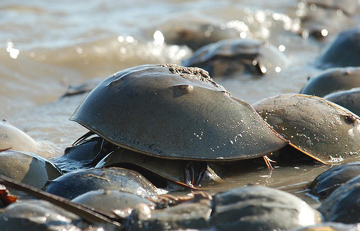The horseshoe crab is an engineering marvel. Its hard shell makes it all but invulnerable to predators. It has “eyes” all over its body to sense even the faintest light, as well as wavelengths of light that are invisible to the human eye. Its blood protects it from bacteria — and forms the basis of a compound that protects us as well. And perhaps most amazing of all, it’s one of the oldest forms of life on Earth, barely changed over hundreds of millions of years. Only four species remain, though — one that’s found from Maine to Mexico, and three others in Asia.
 The horseshoe crab isn’t really a crab — it’s more closely related to spiders and scorpions than true crabs. It has a hard front shell that’s shaped like a horseshoe, plus a long tail that it uses to right itself if it gets turned upside down.
The horseshoe crab isn’t really a crab — it’s more closely related to spiders and scorpions than true crabs. It has a hard front shell that’s shaped like a horseshoe, plus a long tail that it uses to right itself if it gets turned upside down.
The horseshoe crab has 10 “eyes.” Two of them are insect-like compound eyes. Studies of these eyes led to new knowledge about the workings of human eyes. In addition, eyes on its underside help it know which way is up, and light sensors on its tail detect moonlight and other faint sources. And when the Sun goes down, an internal clock flips a switch that makes all the eyes much more sensitive.
A substance in the horseshoe’s blood prevents infections by clotting around invading bacteria. And today, scientists use horseshoe crab blood in a compound that ensures that human vaccines and intravenous medications are also free of infection— a defense provided by an ancient engineering marvel.

